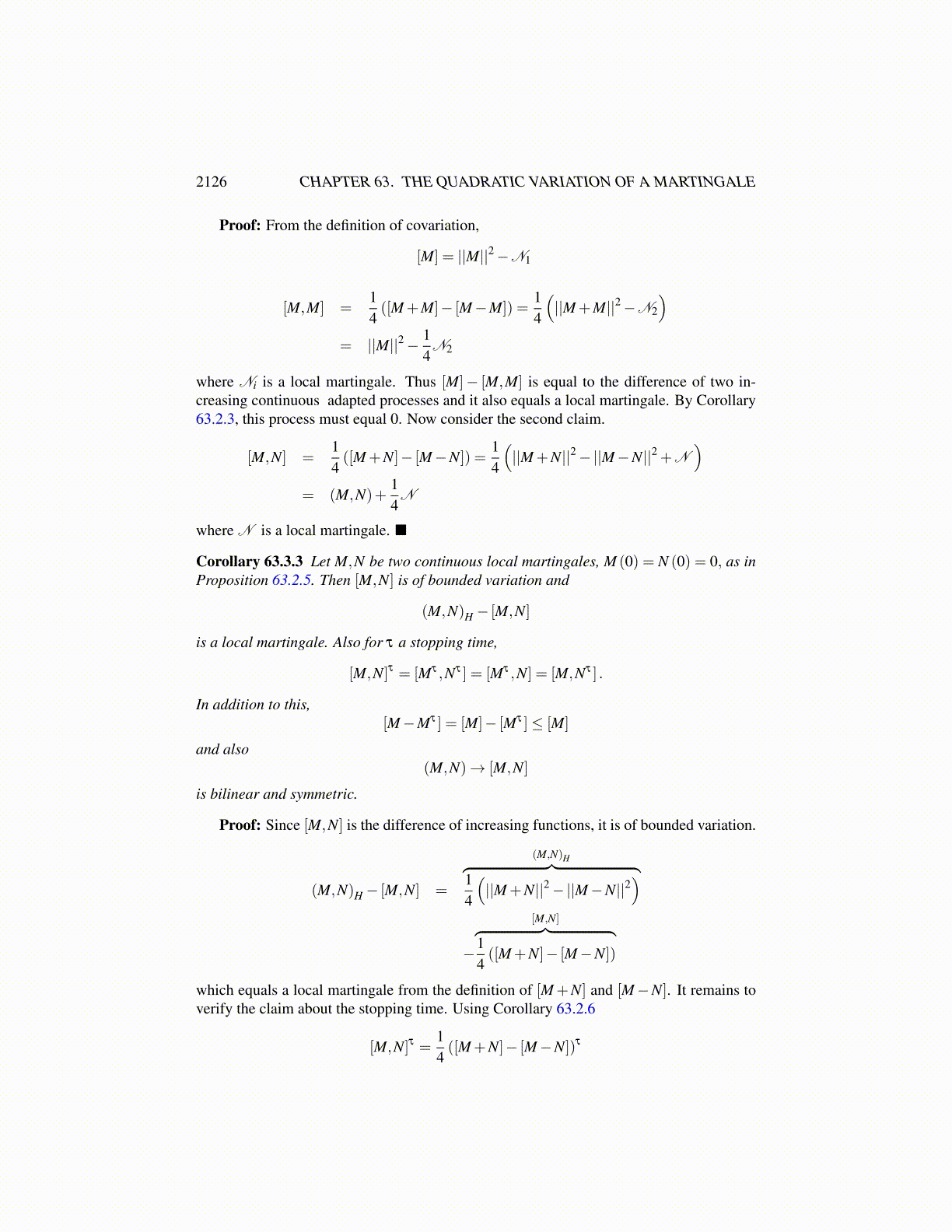
2126 CHAPTER 63. THE QUADRATIC VARIATION OF A MARTINGALE
and Pn (t) is a martingale. Then from 63.2.9, Qn (t) is a submartingale and converges foreach t to something, denoted as [M] (t) in L1 (Ω) uniformly in t ∈ [0,T ]. This is becausePn (t) converges uniformly on [0,T ] to N (t) in L2 (Ω) and ||M (t)||2 does not depend on n.Then also [M] is a submartingale which equals 0 at 0 because this is true of Qn and becauseif A ∈Fs where s < t,∫
AE ([M] (t) |Fs)dP≡
∫A[M] (t)dP = lim
n→∞
∫A
(||M (t)||2−Pn (t)
)dP
= limn→∞
∫A
E(||M (t)||2−Pn (t) |Fs
)dP≥ lim inf
n→∞
∫A||M (s)||2−Pn (s)dP
= lim infn→∞
∫A
Qn (s)dP =∫
A[M] (s)dP.
Note that Qn (t) is increasing because as t increases, the definition allows for the pos-sibility of more nonzero terms in the sum. Therefore, [M] (t) is also increasing in t. Thefunction t→ [M] (t) is continuous because ||M (t)||2 = [M] (t)+N (t) and t→ N (t) is con-tinuous as is t → ||M (t)||2 . That is, off a set of measure zero, these are both continuousfunctions of t and so the same is true of [M] .
Now put back in Mα p∧δ in place of M. From the above, this has shown∣∣∣∣∣∣Mα p∧δ (t)∣∣∣∣∣∣2 = [Mα p∧δ
](t)+Np (t)
where Np is a martingale and[Mα p∧δ
](t) = lim
n→∞∑k≥0
∣∣∣∣∣∣Mα p∧δ(t ∧ τ
nk+1)−Mα p∧δ (t ∧ τ
nk)∣∣∣∣∣∣2
= limn→∞
∑k≥0
∣∣∣∣M (t ∧ τnk+1∧α p∧δ
)−M (t ∧ τ
nk ∧α p∧δ )
∣∣∣∣2 in L1 (Ω) , (63.2.10)
the convergence being uniform on [0,T ] . The above formula shows that[Mα p∧δ
](t) is a
Ft∧δ∧α p measurable random variable which depends on t ∧ δ ∧α p.(Note that t ∧ δ is areal valued stopping time even if δ = ∞.) Therefore, by Proposition 63.2.2, there exists arandom variable, denoted as
[Mδ](t) which is the pointwise limit as p→∞ of these random
variables which is Ft∧δ measurable because, for a given ω, when α p becomes larger than t,the sum in 63.2.10 loses its dependence on p. Thus from pointwise convergence in 63.2.10,[
Mδ
](t)≡ lim
n→∞∑k≥0
∣∣∣∣M (t ∧δ ∧ τnk+1)−M (t ∧δ ∧ τ
nk)∣∣∣∣2
In case δ = ∞, the above gives an Ft measurable random variable denoted by [M] (t) suchthat
[M] (t)≡ limn→∞
∑k≥0
∣∣∣∣M (t ∧ τnk+1)−M (t ∧ τ
nk)∣∣∣∣2
Now stopping with the stopping time δ , this shows that[Mδ
](t)≡ lim
n→∞∑k≥0
∣∣∣∣M (t ∧δ ∧ τnk+1)−M (t ∧δ ∧ τ
nk)∣∣∣∣2 = [M]δ (t)